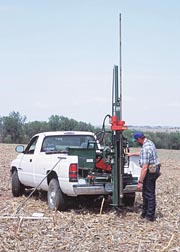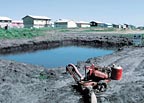

There have been many articles written on the occurrence of metals in ground water due to the turbidity of the samples, which contain suspended inorganic particles that release excess metals into solution when the sample is processed. A similar phenomenon occurs when collected soil samples contain a large percentage of clay. Clays are nature's “junk” deposits that often concentrate leftover minerals sorted from the sedimentary processes. Phosphatic clays in the Hawthorn Formation (southeastern U.S. Coastal Plain) and Wyoming bentonite clays (drilling mud) for example, often contain high concentrations of arsenic, lead, mercury, chromium, etc. If these elements are occurring in soil or ground water samples above action levels, it may be prudent to obtain background samples.
Airborne Fallout
Another source of surface soil contamination is the fallout of ash from burning materials containing contaminants. Some of the contaminants that have been found in measurable quantities on surface soils located near incinerators or boilers include PCBs (present in waste oils), mercury in low-grade coals and pesticides where empty bags formerly containing pesticides were burned.
Agricultural Connection
Soil contamination from pesticides, nitrates and heavy metals has been attributed to former agricultural applications, particularly in areas where former farming areas have been converted to commercial/industrial usage. Arsenic and other heavy metals were once widely used in pesticide applications. I know of one site where the major contaminant of concern was attributed to a compound (herbicide) used for weed control in the ditches near the highway.The point here is if a compound that was never knowingly used on-site is appearing in the analytical results, it may be wise to look for other historic sources in the area. In the case of inorganics (metals) appearing, you should determine the background level of naturally occurring concentrations in the area.



Report Abusive Comment